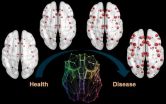(Press-News.org) A new discovery about the atomic structure of uranium dioxide will help scientists select the best computational model to simulate severe nuclear reactor accidents.
Using the Advanced Photon Source (APS), a Department of Energy (DOE) Office of Science User Facility, researchers from DOE's Argonne National Laboratory and Brookhaven National Laboratory, along with Materials Development, Inc., Stony Brook University, and Carnegie Institution of Washington, found that the atomic structure of uranium dioxide (UO2) changes significantly when it melts.
UO2 is the primary fuel component in the majority of existing nuclear reactors, but little is known about the molten state because of its extremely high melting point. Until now, the extremely high temperature and chemical reactivity of the melt have hindered studies of molten UO2. This lack of fundamental information has made it difficult to evaluate issues associated with the interaction of molten UO2 with a reactor's zirconium cladding and steel containment vessel.
The research team found that when uranium dioxide melts, the number of oxygen atoms around uranium changes from eight-fold to a mixture of six- and seven-fold, which changes the way it interacts with other materials. Many existing models, however, do not account for this change in structure or the rapid oxygen dynamics that occur at high temperatures.
"Determining the behavior of UO2 under extreme conditions is essential to enhancing our understanding of reactor safety during severe accidents," said Mark Williamson of Argonne's Chemical Sciences and Engineering Division.
"Very few places in the world have the capability to safely measure the structure of molten UO2 at 3,000 degrees Celsius without introducing contamination from the container that holds the melt," added Chris Benmore of Argonne's X-ray Science Division.
Researchers studied the UO2 in the hot crystalline and molten states. In this experiment, researchers relied on the APS's high-energy synchrotron X-ray beam to study a bead of UO2 that was aerodynamically levitated on a stream of argon and heated with a laser beam.
X-ray experiments were performed at sector 11-ID-C at the APS.
The work was funded by the DOE Office of Science (Office of Basic Energy Sciences), the DOE Small Business Innovation Research program and the Argonne Laboratory Directed Research and Development program.
The paper, "Molten uranium dioxide structure and dynamics," is published in Science magazine. To view the paper, visit the Science website.
"Our group plans to continue to use innovative synchrotron techniques to study molten materials like this," said John Parise, who holds a joint appointment with Brookhaven National Laboratory and Stony Brook University. "The next steps include putting molten materials under different atmospheres, and that requires modifications to the existing set-up used at APS."
Parise said this group of researchers, which includes colleagues from Materials Development, Inc., who built the apparatus used to study UO2, is discussing designs for next-generation levitation devices that could be installed at the X-Ray Powder Diffraction beamline at Brookhaven's National Synchrotron Light Source II, for example.
"There's a lot more work to be done," Parise said. "It's important to understand how many other materials behave in a molten state. Theory is a good way to do that, but theorists need data on how atoms interact with each other in the molten state, under conditions that are as realistic as possible."
INFORMATION:
The authors are Lawrie B. Skinner, of Argonne, Stony Brook University and Materials Development, Inc.; Chris J. Benmore, Mark A. Williamson, Andrew Hebden, Thomas Wiencek and Leonard Leibowitz, all of Argonne; Johann K.R. Weber and Oliver L.G. Alderman, of Argonne and Materials Development; Anthony Tamalonis of Materials Development; Malcolm Guthrie, of the Carnegie Institution of Washington; and John B. Parise, of Stony Brook University.
Rick Spence and Douglas Robinson, both of Argonne's X-ray Science Division, provided technical support and useful discussion.
Argonne National Laboratory seeks solutions to pressing national problems in science and technology. The nation's first national laboratory, Argonne conducts leading-edge basic and applied scientific research in virtually every scientific discipline. Argonne researchers work closely with researchers from hundreds of companies, universities, and federal, state and municipal agencies to help them solve their specific problems, advance America's scientific leadership and prepare the nation for a better future. With employees from more than 60 nations, Argonne is supported by the Office of Science of the U.S. Department of Energy. The Office of Science is the single largest supporter of basic research in the physical sciences in the United States, and is working to address some of the most pressing challenges of our time. For more information, please visit science.energy.gov.
The economic burden of diabetes in America continues to climb, exceeding more than $322 billion in excess medical costs and lost productivity in 2012, or more than $1,000 for every American, according to a study being published in the December issue of Diabetes Care that also includes a state-by-state breakdown of the prevalence and costs associated with diabetes. Additionally, increased costs associated with prediabetes and undiagnosed diabetes highlight the growing importance of prevention and early intervention.
The study, which follows up on a similar report published ...
TAMPA, Fla. - Moffitt Cancer Center researchers are taking a unique approach to understanding and investigating cancer by utilizing evolutionary principles and computational modeling to examine the role of specific genetic mutations in the Darwinian struggle among tumor and normal cells during cancer growth.
Cells become malignant by acquiring genetic mutations that lead to increased survival and reproduction. Many researchers in the past have viewed cancer progression as the result of unlimited accumulation of these genetic mutations. However, Moffitt researchers ...
Fast facts:
The study shows that obesity leads to subclinical heart muscle injury and increases the risk for heart failure even among people without overt heart disease and independently of other cardiovascular risk factors such as diabetes, high blood pressure and high cholesterol.
The silent heart damage was detected by using an ultrasensitive test that measures the levels of a protein released by the cells of the heart muscle during injury.
The findings suggest that obesity is an independent driver of heart muscle damage, and that obese individuals, even when free ...
Massachusetts General Hospital (MGH) investigators have developed a system to accurately track the dynamic process of falling asleep, something has not been possible with existing techniques. In their report in the October issue of the open-access journal PLOS Computational Biology, the research team describes how combining key physiologic measurements with a behavioral task that does not interfere with sleep onset gives a better picture of the gradual process of falling asleep. In addition to being a powerful tool for future research, the system could provide valuable ...
New findings by a Johns Hopkins University-led team reveal long unknown details about carbon deep beneath the Earth's surface and suggest ways this subterranean carbon might have influenced the history of life on the planet.
The team also developed a new, related theory about how diamonds form in the Earth's mantle.
For decades scientists have had little understanding of how carbon behaved deep below the Earth's surface even as they learned more and more about the element's vital role at the planet's crust. Using a model created by Johns Hopkins geochemist Dimitri ...
Twenty-five years ago this month, the countries that compose the United Nations reached a landmark agreement that laid the foundation for much-needed strengthening of children's rights and protections in nearly every country around the world.
Today, the Convention on the Rights of the Child remains the only formal global effort to improve children's rights and the most widely ratified human rights treaty in history. Only three U.N. member nations have not ratified the treaty: Somalia, South Sudan and the United States.
"The Convention on the Rights of the Child is a ...
Ebola GP protein covers the virus' surface and is shed from infected cells during infection. A study published on November 20th in PLOS Pathogens reports that shed GP can trigger massive dysregulation of the immune response and affect the permeability of blood vessels
Ebola virus has seven genes. One of them, called GP, codes for two related proteins: a shorter secreted one and a longer one that spans the viral wall and sticks out of its surface. During virus infection, some of the surface GP is cut off by a human enzyme and is subsequently shed from infected cells. High ...
Researchers from the Montreal Neurological Institute have used a model inspired by patterns of epidemic disease spreading to map how misfolded proteins propagate within the brain.
Proteins which fail to configure correctly (misfolded proteins) are associated with aging and several human neurodegenerative diseases, such as Alzheimer's. In research published in this week's PLOS Computational Biology, Yasser Iturria Medina and colleagues analyze over 700 individual Amyloid-beta proteins imaging datasets to conclude that the propagation of these misfolded proteins, associated ...
An international team of researchers has shown that it may be possible to improve the effectiveness of the seasonal flu vaccine by 'pre-empting' the evolution of the influenza virus.
In a study published today in the journal Science, the researchers, led by the University of Cambridge, describe how an immunological phenomenon they refer to as a 'back boost' suggests that it may be better to pre-emptively vaccinate against likely future strains than to use a strain already circulating in the human population.
Influenza is a notoriously difficult virus against which to ...
RIVERSIDE, Calif. - Yellow fever is a disease that can result in symptoms ranging from fever to severe liver damage. Found in South America and sub-Saharan Africa, each year the disease results in 200,000 new cases and kills 30,000 people. About 900 million people are at risk of contracting the disease.
Now a research team led by a biomedical scientist at the University of California, Riverside has determined that the yellow fever virus, a hemorrhagic fever virus, replicates primarily in the liver. Therefore, other organ failures that often follow in people with the ...




